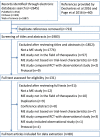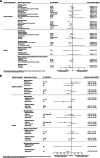Trial-level characteristics associate with treatment effect estimates: a systematic review of meta-epidemiological studies
- PMID: 35705904
- PMCID: PMC9202161
- DOI: 10.1186/s12874-022-01650-5
Trial-level characteristics associate with treatment effect estimates: a systematic review of meta-epidemiological studies
Abstract
Background: To summarize the up-to-date empirical evidence on trial-level characteristics of randomized controlled trials associated with treatment effect estimates.
Methods: A systematic review searched three databases up to August 2020. Meta-epidemiological (ME) studies of randomized controlled trials on intervention effect were eligible. We assessed the methodological quality of ME studies using a self-developed criterion. Associations between treatment effect estimates and trial-level characteristics were presented using forest plots.
Results: Eighty ME studies were included, with 25/80 (31%) being published after 2015. Less than one-third ME studies critically appraised the included studies (26/80, 33%), published a protocol (23/80, 29%), and provided a list of excluded studies with justifications (12/80, 15%). Trials with high or unclear (versus low) risk of bias on sequence generation (3/14 for binary outcome and 1/6 for continuous outcome), allocation concealment (11/18 and 1/6), double blinding (5/15 and 2/4) and smaller sample size (4/5 and 2/2) significantly associated with larger treatment effect estimates. Associations between high or unclear risk of bias on allocation concealment (5/6 for binary outcome and 1/3 for continuous outcome), double blinding (4/5 and 1/3) and larger treatment effect estimates were more frequently observed for subjective outcomes. The associations between treatment effect estimates and non-blinding of outcome assessors were removed in trials using multiple observers to reach consensus for both binary and continuous outcomes. Some trial characteristics in the Cochrane risk-of-bias (RoB2) tool have not been covered by the included ME studies, including using validated method for outcome measures and selection of the reported results from multiple outcome measures or multiple analysis based on results (e.g., significance of the results).
Conclusions: Consistently significant associations between larger treatment effect estimates and high or unclear risk of bias on sequence generation, allocation concealment, double blinding and smaller sample size were found. The impact of allocation concealment and double blinding were more consistent for subjective outcomes. The methodological and reporting quality of included ME studies were dissatisfactory. Future ME studies should follow the corresponding reporting guideline. Specific guidelines for conducting and critically appraising ME studies are needed.
Keywords: Meta-epidemiological study; Randomized controlled trial; Systematic review; Treatment effect estimates; Trial-level characteristic.
© 2022. The Author(s).
Conflict of interest statement
None.
Figures




Similar articles
-
Influence of reported study design characteristics on intervention effect estimates from randomised controlled trials: combined analysis of meta-epidemiological studies.Health Technol Assess. 2012 Sep;16(35):1-82. doi: 10.3310/hta16350. Health Technol Assess. 2012. PMID: 22989478 Review.
-
Compelling evidence from meta-epidemiological studies demonstrates overestimation of effects in randomized trials that fail to optimize randomization and blind patients and outcome assessors.J Clin Epidemiol. 2024 Jan;165:111211. doi: 10.1016/j.jclinepi.2023.11.001. Epub 2023 Nov 7. J Clin Epidemiol. 2024. PMID: 37939743
-
The Empirical Evidence of Bias in Trials Measuring Treatment Differences [Internet].Rockville (MD): Agency for Healthcare Research and Quality (US); 2014 Sep. Report No.: 14-EHC050-EF. Rockville (MD): Agency for Healthcare Research and Quality (US); 2014 Sep. Report No.: 14-EHC050-EF. PMID: 25392898 Free Books & Documents. Review.
-
Empirical evidence of study design biases in nutrition randomised controlled trials: a meta-epidemiological study.BMC Med. 2022 Oct 11;20(1):330. doi: 10.1186/s12916-022-02540-9. BMC Med. 2022. PMID: 36217133 Free PMC article.
-
Trial characteristics and treatment effect estimates in randomized controlled trials of Chinese herbal medicine: A meta-epidemiological study.J Integr Med. 2024 May;22(3):223-234. doi: 10.1016/j.joim.2024.04.003. Epub 2024 Apr 23. J Integr Med. 2024. PMID: 38714484
Cited by
-
Are the results of open randomised controlled trials comparing antipsychotic drugs in schizophrenia biased? Exploratory meta- and subgroup analysis.Schizophrenia (Heidelb). 2024 Feb 15;10(1):17. doi: 10.1038/s41537-024-00442-8. Schizophrenia (Heidelb). 2024. PMID: 38355616 Free PMC article.
-
Inadequate Reporting of Cointerventions, Other Methodological Factors, and Treatment Estimates in Cardiovascular Trials: A Meta-Epidemiological Study.Mayo Clin Proc Innov Qual Outcomes. 2023 Jun 2;7(4):231-240. doi: 10.1016/j.mayocpiqo.2023.04.010. eCollection 2023 Aug. Mayo Clin Proc Innov Qual Outcomes. 2023. PMID: 37304064 Free PMC article.
-
Using protection motivation theory to support patient adherence in healthcare settings: A scoping review.PLoS One. 2025 Sep 2;20(9):e0330883. doi: 10.1371/journal.pone.0330883. eCollection 2025. PLoS One. 2025. PMID: 40892752 Free PMC article.
References
-
- Hróbjartsson A, Thomsen AS, Emanuelsson F, Tendal B, Hilden J, Boutron I, Ravaud P, Brorson S. Observer bias in randomised clinical trials with binary outcomes: systematic review of trials with both blinded and non-blinded outcome assessors. BMJ (Clinical research ed) 2012;344:e1119. doi: 10.1136/bmj.e1119. - DOI - PubMed
Publication types
MeSH terms
LinkOut - more resources
Full Text Sources

